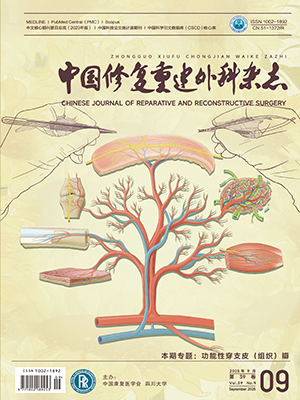Objective To summarize the clinical experiences of various types of the second dorsal metacarpal artery (SDMA) flap for hand reconstruction. Methods From 1988 to 2003, 139 SDMA flaps were transferred for hand injuries. The flaps were used in 5 types according to vascularization and technique in transplantation:orthograde pedicled island SDMA flaps in 37 cases (cutaneous in 24and teno-cutaneous in 13), retrograde pedicled island SDMA flaps in 25 cases(cutaneous in 19 and teno-cutaneous in 6),double pivot SDMA flaps in 36 cases(cutaneous in 28 and teno-cutaneous in 8), distal perforator branch pedicledflaps in 19cases (cutaneous in 16 and composite in 3), free SDMA flaps in 22 cases (cutaneous in 15 and composite in 7). The skin islands were 3.0 cm×1.5 cm to 6.3 cm×5.0 cm in size. Results Of the 139 flaps, 135 flaps survived completely, 3 survived partially, and1 failed in the operation because of intractable vascular spasm. Follow-up wasdone in 116 cases for 12 to 57 months. The flap had good texture and color match. The twopoint discrimination was 5 to 9 mm in 78 sensate flaps, while it was 10 to 15 mm in 38 nonsensate flaps. In 21 tenocutaneous flaps, the TAM score of range of motion was 60% to 70% of the healthy side. Conclusion The SDMA flap has a constant and reliable vessel and a thin, pliable, and good-quality skin. It is versatile in creatingcomposite flaps. It is a good flap resource for hand and finger reconstruction.
Citation: YU Guangrong,YUAN Feng,ZHANG Shimin,et al.. CLINICAL APPLICATION OF SECOND DORSAL METACARPAL ARTERY FLAP IN HAND SURGERY. Chinese Journal of Reparative and Reconstructive Surgery, 2005, 19(7): 521-524. doi: Copy
Copyright © the editorial department of Chinese Journal of Reparative and Reconstructive Surgery of West China Medical Publisher. All rights reserved




